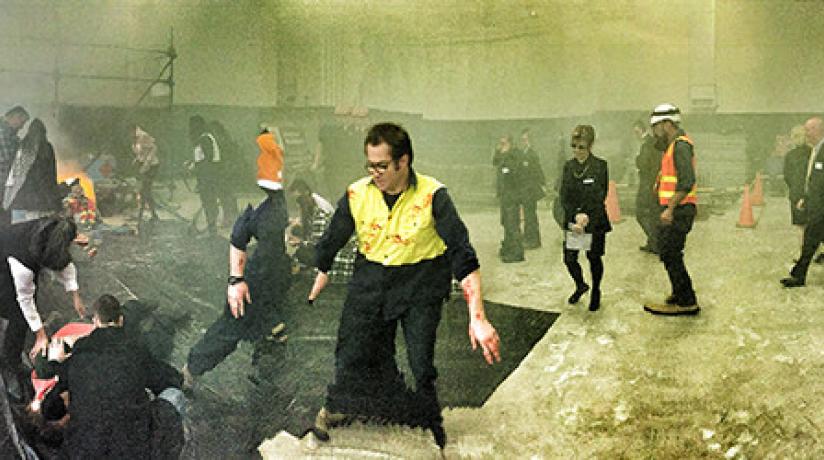The phrase “open house” conjures images of warm hospitality—doors flung open, handshakes, tea and biscuits. When the Building Leadership Simulation Centre held theirs on 22 June, they welcomed 52 guests who looked forward to a glimpse of the facilities the centre had to offer.
Eager to get the tour underway, BLSC Business Development and Relationship Executive Alan Odgers directed guests down a narrow hallway to the warehouse. Then all hell broke loose.
A panicked builder in high visibility clothing staggered down the hall pleading for help, a thick shard of glass embedded in his right temple. Attendees poured into the room behind him, which was thick with smoke and strewn with more injured, bleeding bodies. A crisis siren blared and men screamed in agony amid fallen beams and a smouldering fire.
Reactions were various. Clearly, this was a simulation and none of these actors flecked with stage blood was actually hurt. The demonstration had been produced with the assistance of Real First Aid, a company that specialises in simulated medical emergency training scenarios. Nonetheless, some folks took it seriously, nursing fake wounds and offering words of reassurance. Others stood by with arms folded, feeling awkward, happy to watch the show.
But regardless of audience participation, this demonstration delivered a clear message; the BLSC delivers a realistic, immersive experience—primarily a training resource for the building and construction sector, but with the adaptability and precision to service other industries as well. The ‘soft skills’ training at which the BLSC excels are central to the success of innumerable businesses that rely on staff to navigate the murky waters of interpersonal communication, conflict resolution, diplomacy and creative problem solving.
Important as it may be, the formative learning, practice and coaching required to develop skills in areas such as leadership, meetings, complaints, nenegotiation, delegation and ‘difficult conversations’ can be complex and often difficult to achieve in the workplace. Many employers forego this sort of training altogether, often to their detriment.
The emergency simulation that morning was chosen precisely for its potency. “We believe that most companies have incident response policies and procedures, but have not tested them properly,” BLSC General Manager Marc Lyons says. “We have had a number of clients contact us because when an event actually did occur, their staff did not know or could not follow procedure or respond appropriately under pressure.”
The tour continued behind the scenes, with Marc, Alan and Head of Training and Operations Chris Kulesza. Each led their own contingent through the classrooms (outfitted authentically as site sheds), the 15-metre parabolic-screen simulator and the control room where every action and reaction is monitored and evaluated.
The experiences range from the spectacular to the mundane (like evacuating a worksite or cleaning up a spill), but clients have identified each exercise as crucial to success in their respective working environments, the programs are carefully and expertly choreographed by the staff at BLSC to exercise and hone specific skills.
In order to avoid a situation where students become mere spectators and can avoid direct involvement (as with the demonstration that morning), class sizes are kept small, Lyons explains, with no more than 12 students each. “Social pressure is high, and they have no choice but to dive into the exercise.”
At the end of the tour, guests shared their enthusiasm for the unusual presentation, scheduling time with Marc and his colleagues to make arrangements for their own staff training. Staff at the BLSC has become accustomed to this.
“Our training methods might be unusual,” Odgers said, “but the superlatives they elicit—‘amazing, fantastic, outstanding’ are all quite normal.”





